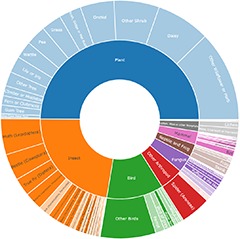Psyllids, lerps, aphids & whiteflies (Hemiptera, several families)
This category covers the Sternorrhyncha, one of the four suborders of the large order Hemiptera (bugs). It contains the Aphids (Aphidoidea) with 3 families and 169 species in Australia, most of which are introduced; the Jumping plant lice or Psyllids or Lerp insects (Psylloidea), very diverse with 6 families and over 400 species; and the Whiteflies (Aleyrodidae) with 119 species. The scale insects (Coccoidea), with 21 families and 854 species, are also classified here, but currently have their own category in NatureMapr.
The majority of Australian Psylloidea species - about 350 - are now classified in the families Aphalaridae and Triozidae.
References
Hollis, David 2004. Australian Psylloidea: jumping plantlice and lerp insects. Australian Biological Resources Study, Canberra
Top contributors
- Hejor1 341
- AlisonMilton 167
- kasiaaus 75
- TimL 59
- ConBoekel 44
- CathB 21
- Mike 18
- KylieWaldon 18
- HelenCross 13
- WendyEM 12
Top moderators
- MichaelMulvaney 714
- KimPullen 72
- MichaelBedingfield 71
- RogerF 13
- KimberiRP 10
- CarbonAI 2
- donhe 2
- DiBickers 2
- abread111 2
- Mike 1


















